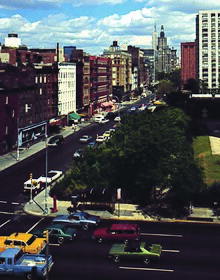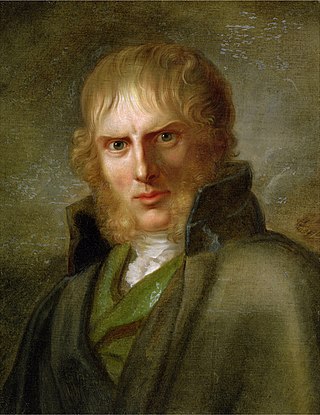
Caspar David Friedrich was a German Romantic landscape painter, generally considered the most important German artist of his generation. He is best known for his allegorical landscapes, which typically feature contemplative figures silhouetted against night skies, morning mists, barren trees or Gothic ruins. His primary interest was the contemplation of nature, and his often symbolic and anti-classical work seeks to convey a subjective, emotional response to the natural world. Friedrich's paintings characteristically set a human presence in diminished perspective amid expansive landscapes, reducing the figures to a scale that, according to the art historian Christopher John Murray, directs "the viewer's gaze towards their metaphysical dimension".

Maya Ying Lin is an American architect, designer and sculptor. Born in Athens, Ohio to Chinese immigrants, she attended Yale University to study architecture. In 1981, while still an undergraduate at Yale she achieved national recognition when she won a national design competition for the planned Vietnam Veterans Memorial in Washington, D.C. The memorial was designed in the minimalist architectural style, and it attracted controversy upon its release but went onto become influential. Lin has since designed numerous memorials, public and private buildings, landscapes, and sculptures. In 1989, she designed the Civil Rights Memorial in Montgomery, Alabama. She has an older brother, the poet Tan Lin.
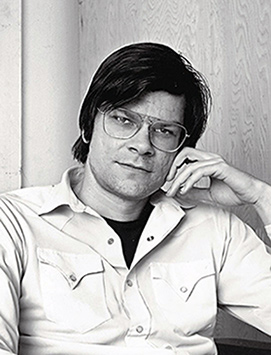
Robert Smithson was an American artist known for sculpture and land art who often used drawing and photography in relation to the spatial arts. His work has been internationally exhibited in galleries and museums and is held in public collections. He was one of the founders of the land art movement whose best known work is the Spiral Jetty (1970).

Land art, variously known as Earth art, environmental art, and Earthworks, is an art movement that emerged in the 1960s and 1970s, largely associated with Great Britain and the United States but that also includes examples from many countries. As a trend, "land art" expanded boundaries of art by the materials used and the siting of the works. The materials used were often the materials of the Earth, including the soil, rocks, vegetation, and water found on-site, and the sites of the works were often distant from population centers. Though sometimes fairly inaccessible, photo documentation was commonly brought back to the urban art gallery.

Site-specific art is artwork created to exist in a certain place. Typically, the artist takes the location into account while planning and creating the artwork. Site-specific art is produced both by commercial artists, and independently, and can include some instances of work such as sculpture, stencil graffiti, rock balancing, and other art forms. Installations can be in urban areas, remote natural settings, or underwater.
Public art is art in any media whose form, function and meaning are created for the general public through a public process. It is a specific art genre with its own professional and critical discourse. Public art is visually and physically accessible to the public; it is installed in public space in both outdoor and indoor settings. Public art seeks to embody public or universal concepts rather than commercial, partisan, or personal concepts or interests. Notably, public art is also the direct or indirect product of a public process of creation, procurement, and/or maintenance.

Environmental art is a range of artistic practices encompassing both historical approaches to nature in art and more recent ecological and politically motivated types of works. Environmental art has evolved away from formal concerns, for example monumental earthworks using earth as a sculptural material, towards a deeper relationship to systems, processes and phenomena in relationship to social concerns. Integrated social and ecological approaches developed as an ethical, restorative stance emerged in the 1990s. Over the past ten years environmental art has become a focal point of exhibitions around the world as the social and cultural aspects of climate change come to the forefront.
Environmental sculpture is sculpture that creates or alters the environment for the viewer, as opposed to presenting itself figurally or monumentally before the viewer. A frequent trait of larger environmental sculptures is that one can actually enter or pass through the sculpture and be partially or completely surrounded by it. Also, in the same spirit, it may be designed to generate shadows or reflections, or to color the light in the surrounding area.

Ugo Rondinone is a Swiss-born artist widely recognized for his mastery of several different media—most prominently sculpture, drawing and painting, but also photography, architecture, video and sound installation—in the largely figurative works he has made for exhibitions in galleries, museums and outdoor public spaces around the world. He has never limited himself to a particular material, no more than he has to a single discipline. Lead, wood, wax, bronze, stained glass, ink, paint, soil and stone are all tools in a creative arsenal that the artist has employed to extend the Romantic tradition in works that are as sensitive to the passage of time as to the nuances of body language and the spoken word.
Agnes Denes is a Hungarian-born American conceptual artist based in New York. She is known for works in a wide range of media—from poetry and philosophical writings to extremely detailed drawings, sculptures, and iconic land art works, such as Wheatfield — A Confrontation (1982), a two-acre field of wheat in downtown Manhattan, commissioned by the Public Art Fund, and Tree Mountain—A Living Time Capsule (1992–96) in Ylöjärvi, Finland. Her work Rice/Tree/Burial with Time Capsule (1968–79) is recognized as one of the earliest examples of ecological art. She lives and works in New York City.

Roy Frank Staab is an American artist.

Patricia Johanson is an American artist. Johanson is known for her large-scale art projects that create aesthetic and practical habitats for humans and wildlife. She designs her functional art projects, created with and in the natural landscape, to solve infrastructure and environmental problems, but also to reconnect city-dwellers with nature and with the history of a place. These project designs date from 1969, making her a pioneer in the field of ecological-art Johanson's work has also been classified as Land Art, Environmental Art, Site-specific Art and Garden Art. Her early paintings and sculptures are part of Minimalism.
Alan Gussow was an American artist, teacher, author and conservationist devoted to and inspired by the natural environment.
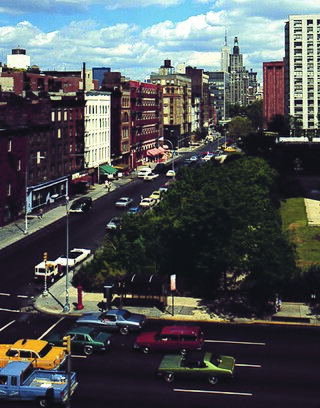
Time Landscape is a landscape artwork by American artist Alan Sonfist. Proposed in 1965, it consists of plants that were native to the New York City area in pre-colonial times. Those planted were replanted here until 1978, on a rectangular plot of 25' x 40' situated in lower Manhattan at the northeast corner of La Guardia Place and West Houston Street. The New York City Department of Parks and Recreation describes the artwork: "When it was first planted, Time Landscape portrayed the three stages of forest growth from grasses to saplings to grown trees. The southern part of the plot represented the youngest stage and now has birch trees and beaked hazelnut shrubs, with a layer of wildflowers beneath. The center features a small grove of beech trees and a woodland with red cedar, black cherry, and witch hazel above groundcover of mugwort, Virginia creeper, aster, pokeweed, and milkweed. The northern area is a mature woodland dominated by oaks, with scattered white ash and American elm trees. Among the numerous other species in this miniforest are oak, sassafras, sweetgum, and tulip trees, arrowwood and dogwood shrubs, bindweed and catbrier vines, and violets." Sonfist's intention was to create a natural memorial akin to war memorials.

Bay View Series is a public artwork by American artist Peter Flanary (artist) located on the Bay View Public Library grounds, which is on the south side of Milwaukee, Wisconsin, United States. Flanary's 1993 Bay View Series consists of three granite rocks and one chunk of taconite iron ore. All have text on them, and the iron ore piece has a hole in the middle. The largest piece measures approximately 68 x 77 x 28 in.
Ecological art is an art genre and artistic practice that seeks to preserve, remediate and/or vitalize the life forms, resources and ecology of Earth. Ecological art practitioners do this by applying the principles of ecosystems to living species and their habitats throughout the lithosphere, atmosphere, biosphere, and hydrosphere, including wilderness, rural, suburban and urban locations. Ecological art is a distinct genre from Environmental art in that it involves functional ecological systems-restoration, as well as socially engaged, activist, community-based interventions. Ecological art also addresses politics, culture, economics, ethics and aesthetics as they impact the conditions of ecosystems. Ecological art practitioners include artists, scientists, philosophers and activists who often collaborate on restoration, remediation and public awareness projects.
Actual Art is a genre of art that was first named by critic Alfred Frankenstein of the San Francisco Chronicle in a review of Helene Aylon’s work. The name was chosen because the art was "real", but the term realism was already in use. Frankenstein described Aylon's work as a genre of art that involves “the self-conscious enlistment of the forces of nature, by artists, toward the completion of their art”. Collaboration with nature necessarily brings the dimension of time into as an integral component of the artworks, with some requiring many thousands of years for their completion. The artists consider the future of the work to be as important as its present, relinquishing control over the work to nature.

Modern sculpture is generally considered to have begun with the work of Auguste Rodin, who is seen as the progenitor of modern sculpture. While Rodin did not set out to rebel against the past, he created a new way of building his works. He "dissolved the hard outline of contemporary Neo-Greek academicism, and thereby created a vital synthesis of opacity and transparency, volume and void". Along with a few other artists in the late 19th century who experimented with new artistic visions in sculpture like Edgar Degas and Paul Gauguin, Rodin invented a radical new approach in the creation of sculpture. Modern sculpture, along with all modern art, "arose as part of Western society's attempt to come to terms with the urban, industrial and secular society that emerged during the nineteenth century".
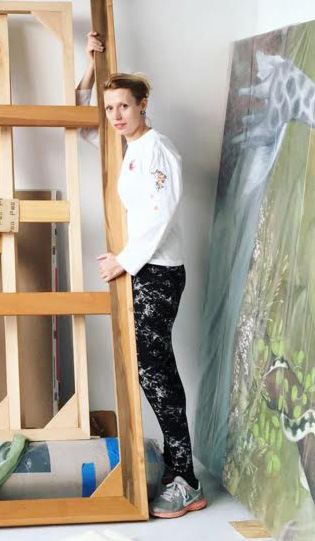
Katerina Lanfranco is a New York City-based visual artist making paintings, drawings, sculptures, and mixed media installations. She was born in Hamilton, Ontario. She studied art at the University of California, Santa Cruz where she received her B.A in Visual Art and in "Visual Theory and Museum Studies". She also attended the Sierra Institute studying Nature Philosophies and Religions while camping in the California wilderness. She received her M.F.A from Hunter College, City University of New York in Studio Art, with an emphasis in painting. In 2004, she studied at the Universitat der Kunst (UdK) in Berlin, Germany on an exchange scholarship. During this time, she also received a travel grant to study Baroque and High Baroque painting in Italy.

Patsy Ann Norvell (1942–2013) was an American visual artist who worked in sculpture, installation art and public art. She was a pioneering feminist artist active in the Women's movement since 1969. In 1972 she was a founder of A.I.R. Gallery which was the first cooperative gallery in the U.S. that showed solely women's work. Her work has been exhibited in galleries and museums in the U.S. and abroad. She received numerous grants, awards and residencies for her achievements, including the Pollock-Krasner Foundation and the National Endowment for the Arts. She created permanent public art works for the New York City subway system, designed and created lobby and plaza installations in Los Angeles, CA, New Brunswick, NJ, Bridgeport, CT, and Bethesda, MD. Her work has received historical and critical acclaim, and has been written about in books, journals and newspapers including, Art in the Land: A Critical Anthology of Environmental Art, in Sculpture (magazine), the Los Angeles Times, The New York Times and numerous other publications.
